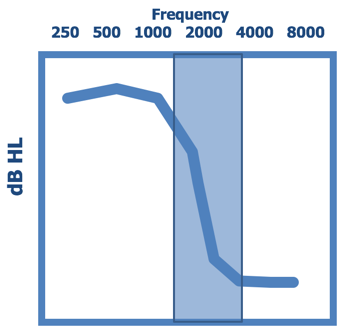Question
What are the goals of fitting hearing aids on patients with a ski-slope hearing loss?
Answer
These are the main goals for fitting patients with ski-slope loss:
- Maintain comfort
- Maintain acceptable sound quality in quiet
- No dramatic frequency responses
- Vented fitting
- Modest audibility enhancement focused on the transition region
- Will be appreciated in quiet
- May be quite helpful in noise
As the first goal, it's important to maintain comfort, as well as maintaining acceptable sound quality in quiet. These patients can get along without hearing aids well enough in quiet that they often believe they don't need hearing aids. They may wait 10 to 20 years before they think about pursuing hearing aids. If they do come into your clinic for hearing aids, make sure to avoid fitting them with a hearing aid that is unnatural or uncomfortable for them. Before feedback cancellation became available in hearing aids, we used to fit these patients with closed ear molds, with BTEs, with high gain in the high frequencies. As a result, they were fighting feedback all the time, creating a lot of occlusion, which is worse when you have usable hearing in the low frequencies. When we create an unnatural, uncomfortable fitting for these patients, it becomes easy for them to reject their hearing aids.
At Oticon, for the last 20 years, we have been using an approach where we focus on a modest audibility enhancement in the mid-frequency region. We want to focus on the transition region of the patient's hearing, the area of the audiograms that Margo Skinner pointed out as being important. This allows us to provide an open fitting. This also allows the patient to have natural sound quality because they're not running into occlusion. By not using an aggressive approach in the very high frequencies, we are maintaining a better sound quality out of the hearing aid, but it still might be enough to allow them to feel like they're doing better in noisy situations than without hearing aids. It's a gentler hand approach fitting these patients. Often, when we present this idea to clinicians, they feel that we are not being aggressive enough in the high frequencies. If we're not going after a full bandwidth speech signal, their view is that we might not be doing enough for these patients. Remember that ski-slope loss patients are typically adults with acquired hearing losses. They have fully acquired speech and language abilities. When you start thinking about how important high frequencies are for adults, they're not going to be as dependent on the very high-frequency parts of the speech spectrum, as perhaps a child learning speech and language, within the auditory system. They've learned to compensate, to use other speech cues, and they've learned that in an ongoing conversation, you don't necessarily need the far end of the speech spectrum.
Let me put this in a different perspective. Figure 1 shows a typical ski-slope loss between 1000 to 3000 Hz. The hearing loss drops off significantly. As stated earlier, with ski-slope losses, you have normal hearing in the low frequencies and significant hearing loss in the high frequencies. However, one of the things that we often forget in audiology is that you also have this transition region (indicated by the shaded area). In this situation, you have this region where the hearing loss is dropping but has not totally bottomed out yet. That typically can be an octave or wider in most losses. I'm not talking about the true cliff audiograms that would occur in some of the ototoxic events. I'm talking about the typical ski-slope losses that are secondary to noise-induced hearing loss.

Figure 1. Ski-slope loss.
This Ask the Expert is an excerpt from Complex versus Standard Fittings: Part 2. Learn more on the Oticon Expo Page on AudiologyOnline.

